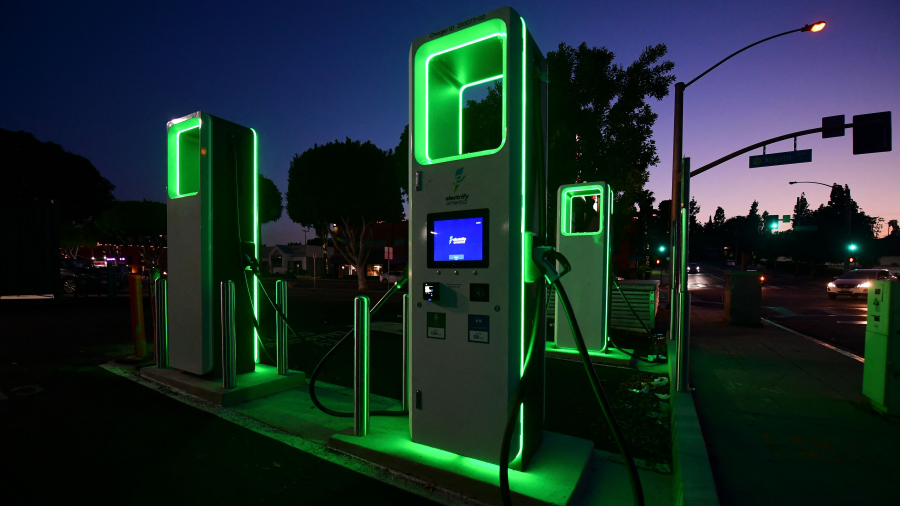How federal funds for EV charging could change the way the U.S. fuels up

The Joe Biden administration wants Americans to fight global warming by speeding up the transition to electric vehicles, and that means we need more charging stations.
Right now, there are around 100,000 chargers nationwide, and the White House says we need at least half a million. A lot of money is going into building them.
The infrastructure law, signed just last month, is sending $5 billion to states to build out the charging network. But what will all this investment look like?
Sam Houston is a senior vehicles analyst for the clean transportation program at the Union of Concerned Scientists. She said the rollout will include multiple types of chargers. The following is an edited transcript of our conversation.
Sam Houston: There are several different kinds that it could be. And I’m talking mostly about the power level. Typically, power level’s divided into three categories. Level one is like just plugging your car into a regular outlet. Level two is like using a kind of outlet that provides more power, like many appliances do, like a clothes dryer in a home. And then level three is that higher power charging that can provide a much higher level of power and therefore charge the vehicle a bit more quickly. So, for the most part, we would expect to see that higher power charging being the charging installed along highways. And I think as we move into the future, we’ll see higher and higher power, and therefore faster and faster charging being possible.

Kimberly Adams: Let’s say, five years from now, this all gets rolled out the way the Biden administration wants it to, and I get an electric vehicle. How am I going to experience all of this funding out in the world?
Houston: These chargers should be installed at places where you’d already want to stop on a road trip. So that could be a local restaurant or grocery store in a town that you’re passing through. You plug in while you’re there, and you can have your break and carry on whenever you’re finished.
Adams: Will all these chargers work with all the electric vehicles?
Houston: The short answer is no. Where the [direct current] fast charging is concerned, there are several different kinds of plugs. The good news is one kind of plug, which is called CHAdeMO, is basically being phased out. So most of the industry is really gathering around another kind of plug, which is called CCS [or combined charging system]. So that’s good — that’ll increase the potential for interoperability. Of course, Teslas have their own proprietary Tesla-specific fast charging plug. And so drivers will want to, as they’re planning their road trips, ensure that they are going to be passing through stations that either have their plug type, or they have the adapter for that plug type.
Adams: A lot of EV charging is done at home by consumers rather than on the road. How does that change the way that the government will roll out this plan and that funds will be distributed?
Houston: These programs in the infrastructure and jobs act really address the longer-term, or longer-distance, rather, travel. Some drivers face barriers to installing charging at home. That could be for a variety of reasons. They may rent, or even if they own a condo, they’re in a multiunit dwelling where you have to get everyone on board from the landlord or homeowner association and the drivers and the other residents. And so until we have more ubiquitous access to easy home charging, some people may still be able to adopt an electric vehicle by using one of the community sites that we were speaking about earlier. And I actually have a couple of friends who are in that situation, and they’ve been making it work.
Related links: More insight from Kimberly Adams
The White House has a state-by-state fact sheet laying out just how much each state and territory is expected to get in EV charging funds.
Back in my home state of Missouri, for example, the formula for allocating the funding would send almost $100 million over five years to help build up charging infrastructure.
There’s another $2.5 billion in grant money for increasing access to electric charging and other alternative fuels, like natural gas, along major travel routes. The Biden administration says the grant program is meant to prioritize low-income and rural communities, places that have been mostly left out of current EV charging networks.
And Houston has her own fact sheet from the Union of Concerned Scientists with even more details about the different types of chargers and how the group thinks they should be deployed.
Vox’s Recode points out that while this is a lot of money for EV charging, it is less ambitious than the administration’s original plan. Like, half-the-money less ambitious.
So, as they explain in the article, to build the same number of chargers with half the budget means more of those chargers will be slower and less expensive.
The future of this podcast starts with you.
Every day, the “Marketplace Tech” team demystifies the digital economy with stories that explore more than just Big Tech. We’re committed to covering topics that matter to you and the world around us, diving deep into how technology intersects with climate change, inequity, and disinformation.
As part of a nonprofit newsroom, we’re counting on listeners like you to keep this public service paywall-free and available to all.
Support “Marketplace Tech” in any amount today and become a partner in our mission.


















